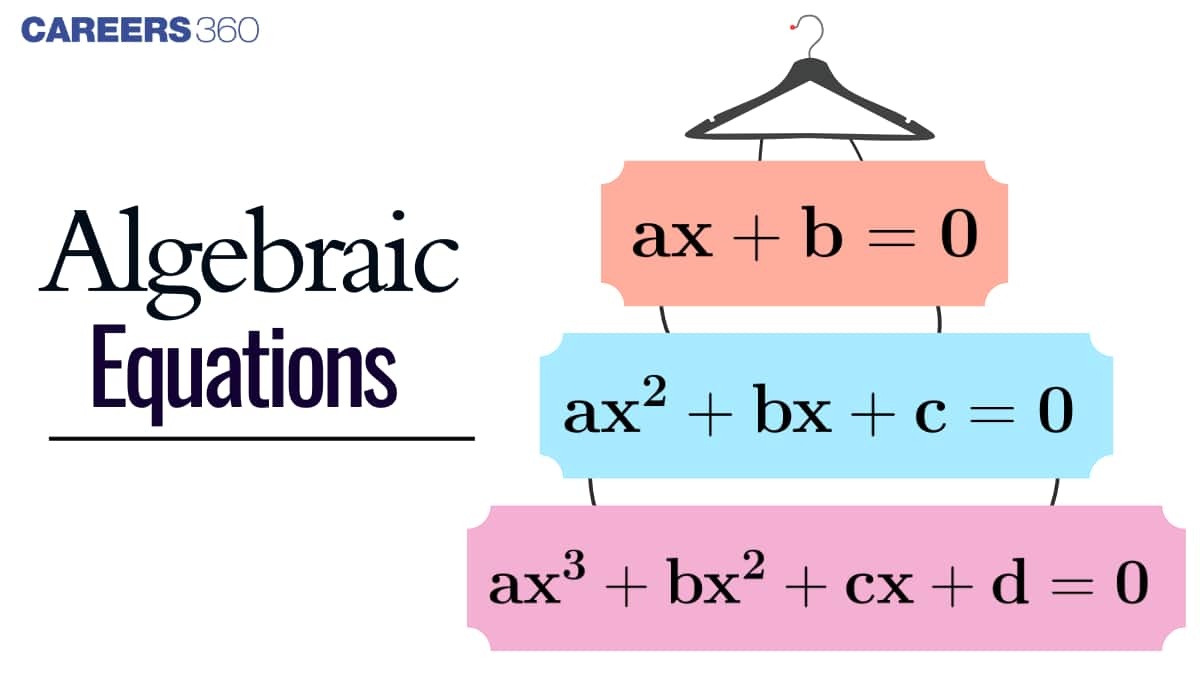Algebraic Equations - Definition, Types, Formulas, Examples
A mathematical statement in which two expressions are made equal to one another is known as an algebraic equation. A variable, coefficients, and constants are the typical components of an algebraic equation. Equations, or the equal sign, simply signify equality. The main purpose of equations is to equate two quantities. Equations act as a scale of balance. Anything on one side of the equal sign must have the same value on the opposite side for it not to be considered unequal. Because polynomials are included on both sides of the equal sign, algebraic equations are also referred to as polynomial equations. When a number or collection of numbers satisfies an algebraic equation, they are referred to as the equation's roots or solutions.
This Story also Contains
- What Are Algebraic Equations?
- What Is An Equation?
- Types Of Algebraic Equations
- What Is An Algebraic Expression?
- Formulas For Algebraic Equations
- How Are Algebraic Equations Solved?
- Points To Remember

What Are Algebraic Equations?
A balanced equation with variables, coefficients, and constants is what is known as an algebraic equation.
An equation with the following form is an algebraic equation:
Q = 0
Here, Q represents a polynomial.
For instance, a + 6 = 0 is an algebraic equation, here (a+6) represents a polynomial. It is sometimes known as a polynomial equation for this reason.
Make sure that every change on one side of the equation is reflected on the other side to prevent making a mistake that throws the equation out of balance. For instance, you must add the identical number, 6, to the other side of the equation if you want to add 6 to one side of it. The same holds true for division, multiplication, and subtraction. Equations in algebra with only one variable are referred to as univariate equations, while equations with several variables are referred to as multivariate equations.
What Is An Equation?
An equation is a mathematical expression that explains the connection between two values. The two values are normally equated with an equal sign in an equation. For instance, 3x + 6 = 18.
In this equation, x is the only variable. 3x,6, and 18 are the terms. 6 and 18 are the constants. ‘+’ is the operator.
Types Of Algebraic Equations
There are various kinds of algebraic equations. Several of the algebraic equations are:
Polynomial Equations - A polynomial equation is one with variables, exponents, and coefficients.
Quadratic Equations - A polynomial equation with degree 2 and only one variable is referred to as a quadratic equation. It has the form, $f(x)=ax^{2}+bx+c$
Here, the value of a is non-zero.
Cubic Equations - The degree three polynomials are cubic polynomials. Algebraic equations also exist for every cubic polynomial. They are of the form: $ax^{3}+bx^{2}+cx+d=0$
Rational Polynomial Equations - These are equations of the form, $\frac{P(x)}{Q(x)} = 0$.
Trigonometric Equations - A trigonometric equation is one that contains the trigonometric functions of a variable. For instance, $\sin2x=1+6\cos x$
What Is An Algebraic Expression?
An algebraic expression is a polynomial that consists of variables, coefficients, and constants connected by operations like addition, subtraction, multiplication, division, and non-negative exponentiation. It is important to distinguish between an algebraic expression and an algebraic equation. An algebraic equation is created when two algebraic expressions are combined using the "equal to" sign.
Formulas For Algebraic Equations
Numerous formulas and identities can be used to simplify algebraic equations. These speed up the process of solving a particular equation. Some significant algebraic formulas are shown below:
$(a+b)^{2}=a^{2}+2ab+b^{2}$

$(a-b)^{2}=a^{2}-2ab+b^{2}$

$(a+b)(a-b)=a^{2}-b^{2}$

$(x+a)(x+b)=x^{2}+(a+b)x+ab$

$(a+b)^{3}=a^{3}+3a^{2}b+3ab^{2}+b^{3}$

$(a-b)^{3}=a^{3}-3a^{2}b+3ab^{2}-b^{3}$

$a^{3}+b^{3}=(a+b)(a^{2}-ab+b^{2})$

$a^{3}-b^{3}=(a-b)(a^{2}+ab+b^{2})$

$(a+b+c)^{2}=a^{2}+b^{2}+c^{2}+2ab+2bc+2ca$

How Are Algebraic Equations Solved?
Depending on the degree, a variety of methods are available to solve algebraic equations. In order to solve an algebraic equation with two variables, two equations must be used. As a result, it can be claimed that the number of variables contained in an algebraic equation will determine how many equations are needed to solve it.
Points To Remember
An algebraic equation is one that is created by combining two algebraic expressions with an equal sign.
Equations involving algebra can be one-, two-, or multiple-step equations.
Based on the degree, algebraic equations are categorized as linear, quadratic, cubic, and higher-order equations.
Frequently Asked Questions (FAQs)
An algebraic expression is a polynomial that consists of variables, coefficients, and constants connected by operations like addition, subtraction, multiplication, division, and non-negative exponentiation.
A variable, coefficients, and constants are the typical components of an algebraic equation.
Equations in algebra with only one variable are referred to as univariate equations, while equations with several variables are referred to as multivariate equations.
There are various kinds of algebraic equations. Several of the algebraic equations are:
Polynomial Equations
Quadratic Equations
Cubic Equations
Rational Polynomial Equations
Trigonometric Equations